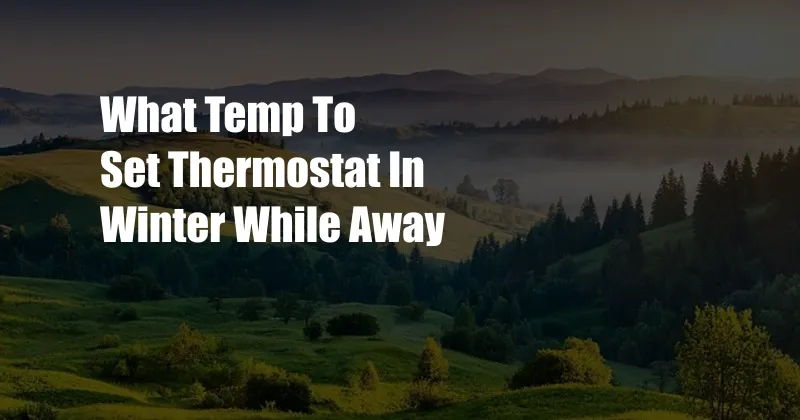
What Temperature to Set Thermostat in Winter While Away: A Comprehensive Guide
As winter approaches, it’s crucial to adjust our home thermostats for optimal energy efficiency and comfort, especially when we’re away. Setting the right temperature can help save energy, prevent frozen pipes, and maintain a comfortable indoor climate upon our return. In this article, we will delve into the ideal temperature to set your thermostat while away, exploring its benefits and providing expert tips and advice.
Let’s imagine you’re planning a winter getaway for a few days. While you’re excited to escape the cold, you’re also concerned about leaving your home unprotected from the freezing temperatures. By optimizing your thermostat settings, you can ensure a safe and energy-efficient return home.
Setting the Ideal Away Thermostat Temperature
The ideal temperature to set your thermostat while away in winter is between 55°F and 60°F (13°C and 16°C). This range helps maintain a level of warmth to prevent pipes from freezing while minimizing energy consumption.
Setting the thermostat too low, below 55°F (13°C), risks frozen pipes, while setting it too high, above 60°F (16°C), wastes energy and increases heating costs. Additionally, if you have pets or plants, you may need to adjust the temperature accordingly to ensure their well-being.
Understanding Thermostat Programming
Modern thermostats often have programmable features, allowing you to set different temperatures for different times of the day. For example, you could program your thermostat to maintain a lower temperature during the night and when you’re away, then automatically adjust to a more comfortable temperature before you return home.
By using programmable thermostats, you can further optimize your energy usage and create a more customized indoor climate. Many thermostats also offer remote access through mobile apps, enabling you to monitor and adjust the temperature from anywhere.
Energy Savings and Comfort
By setting your thermostat to 55-60°F (13-16°C) while away, you can significantly reduce your energy consumption. Studies show that lowering your thermostat by just 1 degree can save up to 3% on your energy bill.
Furthermore, maintaining a slightly cooler temperature while away helps acclimate your home to a lower temperature, making it easier to warm up quickly upon your return. This balance between energy efficiency and comfort ensures a comfortable indoor environment without excessive heating.
Tips from the Experts
To maximize energy savings and comfort while away, follow these expert tips:
- Lower the thermostat to 55-60°F (13-16°C) when you’re away.
- Use programmable thermostats to set different temperatures for different times.
- Consider installing a smart thermostat for remote control and energy optimization.
- Seal air leaks around windows and doors to prevent cold air from entering.
- Close curtains and blinds to reduce heat loss through windows.
By implementing these tips, you can create a more energy-efficient and comfortable home, even when you’re away. Remember to adjust the temperature settings upon your return to your desired comfort level.
Frequently Asked Questions
- Q: How low can I set my thermostat without freezing pipes?
- A: 55°F (13°C) is the recommended minimum temperature to prevent pipes from freezing.
- Q: Should I turn off my heat completely while away?
- A: No, leaving the heat off can increase the risk of frozen pipes. Instead, set the thermostat to a low temperature, such as 55°F (13°C).
- Q: How can I save energy while away without compromising comfort?
- A: Lower the thermostat to 55-60°F (13-16°C), close off unused rooms, and seal air leaks to maintain a comfortable indoor climate while saving energy.
Conclusion
By setting your thermostat to the ideal temperature of 55-60°F (13-16°C) while away in winter, you can achieve significant energy savings, prevent frozen pipes, and ensure a comfortable indoor climate upon your return. By following the expert tips and advice provided in this article, you can optimize your thermostat settings, enhance your home’s energy efficiency, and enjoy peace of mind knowing your home is protected from the cold.
Are you interested in learning more about energy-efficient home heating and cooling strategies? Explore our website for additional resources and expert insights.